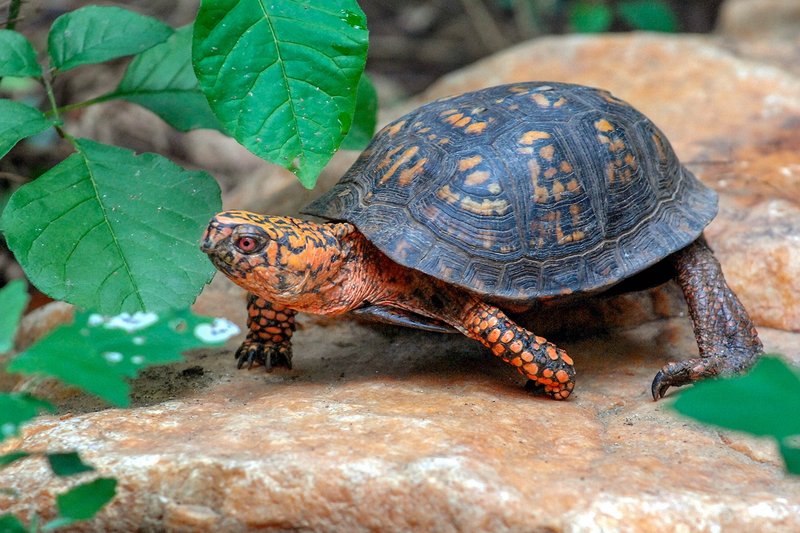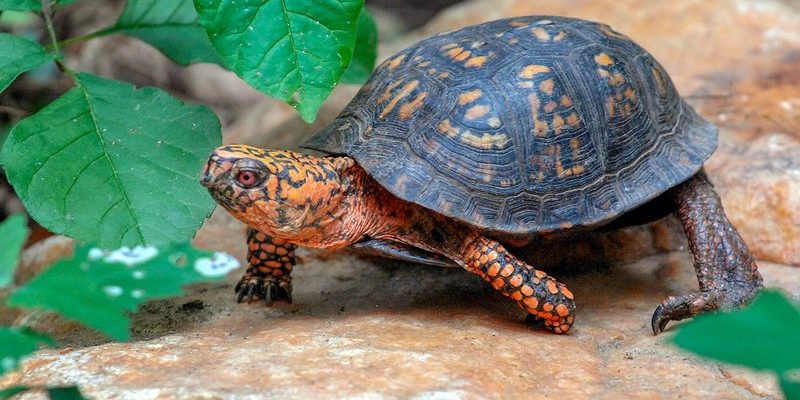
Box turtles are not just any turtles. They are part of the family Emydidae and are known for their unique, hinged shells that can close completely—a characteristic that sets them apart from many other turtle species. This clever feature is like having a personal fortress! These turtles are also found primarily in North America, particularly in wooded and grassland areas. But beyond their habitats and protective shells, there’s so much more to discover about these captivating creatures. So, let’s explore ten intriguing facts that might make you see box turtles in a new light.
1. They Have Unique Shells
Box turtles are best known for their distinctive shells. Unlike most turtles, which have soft, rounded shells, box turtles sport a domed carapace that can close up tight. This functionality is thanks to a special hinge on the bottom shell, or *plastron*, allowing them to pull their bodies in and seal off any predators. It’s like having a portable safe space! Each turtle’s shell pattern is unique, much like a human fingerprint. This individuality helps researchers identify and track these creatures in the wild.
You might be wondering how these shells protect them. When threatened, a box turtle will withdraw into its shell, effectively becoming a small, armored fortress. This adaptation not only deters many predators but also helps them avoid environmental dangers, like harsh weather. Imagine being able to carry your home with you and hide away anytime you feel threatened. That’s the life of a box turtle!
2. They Age Like Fine Wine
Box turtles are some of the longest-lived reptiles out there. In the wild, they can live anywhere from 50 to over 100 years! It’s pretty mind-blowing when you think about it. Just imagine a box turtle basking in the sun while witnessing the world change over decades. Their long lifespan is partly due to their slow metabolism and relatively sedentary lifestyle.
However, just like with humans, their age can sometimes be gauged by their shells. The rings on a turtle’s shell can give insight into its age, similar to tree rings. But it’s worth noting that environmental factors can affect growth rates, making it tricky to pinpoint exact ages. So, if you ever come across an old box turtle, remember that it likely has some incredible stories to tell!
3. Box Turtles Are Omnivores
When it comes to their diet, box turtles are true omnivores. They enjoy a wide range of foods, including fruits, vegetables, insects, and even small animals. This varied diet allows them to adapt to different environments and food availability. Talk about being flexible!
Their eating habits can be pretty interesting, too. You might catch a box turtle munching on strawberries one day and snacking on earthworms the next. This variety not only keeps their diet balanced but also contributes to their overall health. Think of them as the foodies of the turtle world, always sampling what nature has to offer. Just imagine the culinary journey they go on in their natural habitats!
4. They Can Be a Bit Shy
Box turtles are known for their introverted nature. Unlike some of their more outgoing reptilian cousins, box turtles tend to be more reserved and prefer to stay hidden in their shells. If you approach one too quickly, it might retreat immediately, pulling its head and legs inside as if to say, “I need a moment!”
This behavior isn’t just endearing; it’s a survival tactic. Being shy helps them stay away from predators, giving them the advantage they need in wild environments. If you’re ever lucky enough to spot a box turtle, remember to give it some space. They may take a while to warm up to you, but aren’t we all a little shy sometimes?
5. They Have a Unique Sense of Direction
Box turtles possess a remarkable ability to navigate their environments. They can find their way home even after being relocated several miles away, which is surprising! This skill is thought to be tied to their magnetic sense and environmental cues, like the position of the sun.
It’s fascinating to think about how they can pinpoint their location. Some studies suggest they might use visual landmarks to help guide them. So, if a box turtle seems to be wandering in circles, it’s just trying to find its way back home—not lost, just on a little adventure. If only we had a fraction of their navigation skills when it comes to finding our way around a new city!
6. They Are Ground Dwellers
Unlike many turtles that enjoy swimming, box turtles are primarily land dwellers. They thrive in habitats like forests, grasslands, and wetlands but seldom venture into deep water. Instead, they prefer to explore their surroundings on solid ground. This sets them apart from their aquatic relatives, who might find comfort in the water.
Being ground dwellers, box turtles are often seen digging around for food or basking in the sun on warm days. They tend to favor moist areas and can be found beneath leaves, bushes, or logs—perfect little hideaways. The best part? They can often be spotted during the day, making them a treat for nature enthusiasts and casual hikers alike.
7. Climate Change and Their Survival
As adorable and resilient as box turtles are, they aren’t immune to the challenges posed by climate change. Their slow reproduction rates mean that populations can decrease rapidly in the face of environmental changes. Rising temperatures, habitat destruction, and changing ecosystems impact their survival.
For instance, warmer temperatures can threaten their hibernation patterns, leading to potential mismatches in food availability. Moreover, urban development can destroy their natural habitats, making it harder for box turtles to thrive. It’s a delicate balance that requires attention and action from all of us to ensure these charming creatures continue to exist and flourish.
8. They Are Part of a Larger Ecosystem
Box turtles play a crucial role in their ecosystems beyond being adorable little creatures. As omnivores, they help maintain the balance of their environments by controlling insect populations and aiding in seed dispersal through their eating habits. This means they contribute to the growth of new plants and trees, making them vital to their habitats.
By eating fruits and then shedding the seeds elsewhere, box turtles promote plant diversity. It’s like they’re little gardeners, helping to shape their environment with every bite! Their presence supports various species and contributes to a healthy ecosystem. So, the next time you admire a box turtle, remember that it’s not just sitting there; it’s hard at work supporting its home!
9. They Can Be Territorial
You may be surprised to learn that box turtles can be territorial creatures. Males, in particular, will defend their territory during mating seasons, often engaging in head-bobbing displays or gentle nudging with their shells. It’s like a little dance, with each turtle showcasing its confidence to potential mates.
This territorial behavior can sometimes lead to skirmishes between males. It’s all part of their natural instincts, as they strive to find the best partners and ensure the survival of their lineage. So, if you ever notice two box turtles sparring, don’t worry—they’re just doing what comes naturally!
10. Conservation Efforts Are Underway
With the threats posed by climate change and habitat loss, various conservation efforts are being implemented to protect box turtles. Organizations are working to create awareness and preserve their habitats, making strides toward ensuring these remarkable creatures continue to thrive.
You may even find opportunities to volunteer or support these efforts through local wildlife organizations. Every action counts, whether it’s educating others about box turtles, participating in habitat restoration, or simply sharing what you’ve learned. Together, we can help these enchanting creatures flourish for generations to come.
Wrapping up, box turtles may seem like simple reptiles, but they’re anything but ordinary. From their unique shells to their long lifespans and vital roles in ecosystems, they’re a fascinating part of our natural world. Next time you encounter a box turtle, take a moment to appreciate all the amazing things you’ve learned about them today. Who knows? You might just spark a conversation about these intriguing creatures that could inspire someone else to protect them!

